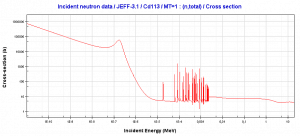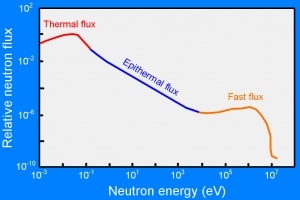Free neutrons can be classified according to their kinetic energy. This energy is usually given in electron volts (eV). The term temperature can also describe this energy representing thermal equilibrium between a neutron and a medium with a certain temperature.
Classification of free neutrons according to kinetic energies
- Cold Neutrons (0 eV; 0.025 eV). Neutrons in thermal equilibrium with very cold surroundings such as liquid deuterium. This spectrum is used for neutron scattering experiments.
- Thermal Neutrons. Neutrons in thermal equilibrium with a surrounding medium. Most probable energy at 20°C (68°F) for Maxwellian distribution is 0.025 eV (~2 km/s). This part of the neutron’s energy spectrum constitutes the most important spectrum in thermal reactors.
- Epithermal Neutrons (0.025 eV; 0.4 eV). Neutrons of kinetic energy are greater than thermal. Some reactor designs operate with an epithermal neutron spectrum. This design allows reaching a higher fuel breeding ratio than in thermal reactors.
-

Neutrons of kinetic energy below the cadmium cut-off energy (~0.5 eV) are strongly absorbed by 113-Cd.
Source: JANIS (Java-based nuclear information software) www.oecd-nea.org/janis/Cadmium Neutrons (0.4 eV; 0.5 eV). Neutrons of kinetic energy below the cadmium cut-off energy. One cadmium isotope, 113Cd, absorbs neutrons strongly only if they are below ~0.5 eV (cadmium cut-off energy).
- Epicadmium Neutrons (0.5 eV; 1 eV). Neutrons of kinetic energy above the cadmium cut-off energy. These neutrons are not absorbed by cadmium.
- Slow Neutrons (1 eV; 10 eV).
- Resonance Neutrons (10 eV; 300 eV). The resonance neutrons are called resonance for their special behavior. At resonance energies, the cross-sections can reach peaks more than 100x higher than the base value of the cross-section. At these energies, the neutron capture significantly exceeds the probability of fission. Therefore it is very important (for thermal reactors) to quickly overcome this range of energy and operate the reactor with thermal neutrons increasing the probability of fission.
- Intermediate Neutrons (300 eV; 1 MeV).
- Fast Neutrons (1 MeV; 20 MeV). Neutrons of kinetic energy greater than 1 MeV (~15 000 km/s) are usually named fission neutrons. These neutrons are produced by nuclear processes such as nuclear fission or (ɑ,n) reactions. The fission neutrons have mean energy (for 235U fission) of 2 MeV. Inside a nuclear reactor, the fast neutrons are slowed down to thermal energies via a process called neutron moderation.
- Relativistic Neutrons (20 MeV; ->)

Source: serc.carleton.edu
The reactor physics does not need this fine division of neutron energies. The neutrons can be roughly (for purposes of reactor physics) divided into three energy ranges:
- Thermal neutrons (0.025 eV – 1 eV).
- Resonance neutrons (1 eV – 1 keV).
- Fast neutrons (1 keV – 10 MeV).
Even most reactor computing codes use only two neutron energy groups:
- Slow neutrons group (0.025 eV – 1 keV).
- Fast neutrons group (1 keV – 10 MeV).